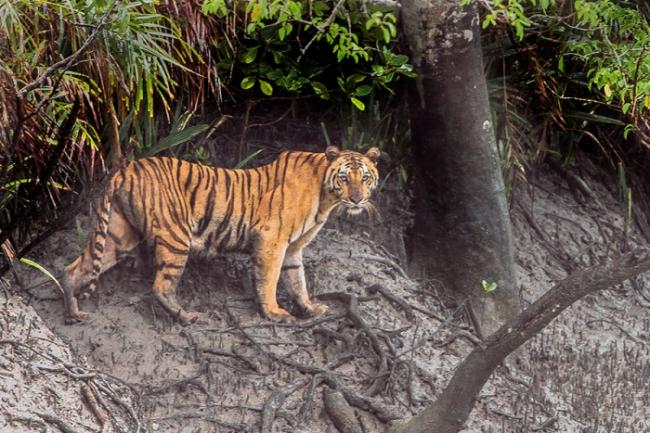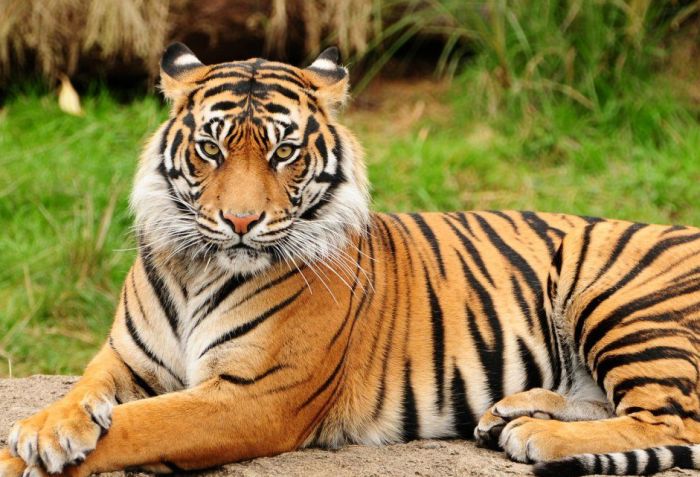
Here come the Sundarban tigers
While less human lives are lost from tiger attacks now the big cat population is not declining in the India's Sundarbans National Park (SNP), the world’s biggest mangrove forest and genepool and UN heritage-listed natural wonder, say officials of the forest department in West Bengal.
While not all incidents of tiger attacks reach the mainstream media, one that made headlines was when a villager who was crab fishing in June 2014 was snatched away from a fishing boat by a tiger as his children looked on helplessly.
Sushil Manjhi was crab fishing with his son and daughter when the tiger leaped aboard the boat and preyed him, dragging him in the mangrove swamp and then disappeared with his body.
While stories of man animal conflict abounds, the Park authorities say they carry out meticulous conservation efforts. A 96 km long nylon net has been strung across the village-forest interface to prevent straying of the beast into human habitation.
'We carry out extensive awareness campaigns among locals to dissuade them from going into the core area,' says Nilanjan Mallick, Chief Conservator of Forest and Field Director, Sunderbans Tiger Reserve.
'SNP is the only forest in India where no human habitation has been allowed,' he said.

Not just that, intensive patrolling is carried out in the buffer and core areas and at strategic locations in the Sunderbans National Park which was brought under the Indian Wildlife Protection Act in 1973. The patrolling is as much to contain man from venturing into the restricted area as to ward off poachers-- a major threat to the striped beast.
The Sunderbans National Park, located at the South Eastern tip of the South and North 24 Paraganas districts in West Bengal, got its name from one of the mangrove plants known as Sundari (Heritiera Minor).
The Sundarbans are a part of the world's largest delta formed by the rivers Ganges, Brahmaputra and Meghna. Sundarbans is a vast area covering 4262 square km in India alone, with a larger portion in Bangladesh. The 2585 sq. km of the Indian Sundarbans forms the largest Tiger Reserve and National Park in India.
It mainly consists of mangrove forests. The core area of the park has it's own natural boundaries with the river Matla on it's West, the river Haribhanga on it's East and Netidhopani and Gosba in the North.
Sunderbans tigers are a little smaller and slimmer than those elsewhere in India but remain extremely powerful and are infamous for destroying small wooden boats. They are not the only big cats who live close to humans though.
The locals and government officials take certain precautions to prevent attacks. Local fishermen will say prayers and perform rituals to the forest goddess Bonbibi before setting out on expeditions.
Invocations to the tiger god Dakshin Rai are also considered a necessity by the local populace for safe passage throughout the Sundarbans area. Fishermen and bushmen originally created masks made to look like faces to wear on the back of their heads because tigers always attack from behind.
Even at the rate of fifty or sixty kills per year, humans would provide only about three per cent of the yearly food requirements for the tiger population of the Sundarbans. Thus, humans are only a supplement to the tiger's diet, not the primary food source.
This does not mean that the notoriety associated with this area is unfounded. Even if only 3% of a tiger's diet is human meat, that still amounts to the tiger killing and eating about one person per year, given the amount of food a tiger typically eats.
Villagers in the area have agreed to occasionally release livestock into the forest in order to provide an alternative food source for the tigers and discourage them from entering the villages. The government has agreed to subsidize the project to encourage village participation.
'The human death rate has dropped significantly due to better management techniques and fewer people are killed each year,' Mallick maintained.
'No illegal entry is allowed. Neither is encroachment encouraged,' he specified.
The efforts have brought in two-fold results. Human casualty has decreased and the number of tigers has increased.
Before modern times, Sundarbans were said to "regularly kill fifty or sixty people a year". The number has drastically slumped to three kills a year now, according to statistics.
On the brighter side the number of tiger has registered an upswing.
According to Mr Mallick camera trappings carried out in 2015-16 showed their number at more than 86. 'This number though does not include cubs and sub-adults,' the Chief Conservator said.
Despite all efforts some people do sneak in, he rued.
Apart from poaching, which has been considerably contained, threat to the king of the jungle comes from another quarter.
'The tiger may slowly lose its habitat as the rise in sea level because of global warming may swamp land,' Mr Mallick warned.
The four Sunderbans National Park have been lumped together as they all share common features of the estuarine mangrove ecosystem.
The park area is divided into two ranges. Each range is further sub-divided into beats.
The park also has floating watch stations and camps to protect the property from poachers.
 Forest guards work round the clock in Sundarbans to prevent man animal conflict
Forest guards work round the clock in Sundarbans to prevent man animal conflict
The delta also harbours large reptiles like the Monitor Lizard, Estuarine Crocodile and the Olive Ridley Turtle, for which there is a conservation programme in the Indian park. The Leopard, Indian Rhinoceros, Javan Rhinoceros, Swamp Deer, river terrapin, Ganga river dolphin, hawksbill turtle, Hog Deer and Water Buffalo have all become locally extinct from the delta in recent decades.
It is also home to a variety of bird, reptile and invertebrate species.
The present Sundarban National Park was declared as the core area of Sundarban Tiger Reserve in 1973 and a wildlife sanctuary in 1977. On May 4, 1984 it was declared a National Park. It is a UNESCO world heritage site inscripted in 1987. It is considered as a World Network of Biosphere Reserve (Man and Biosphere Reserve) in 2001.
The natural environment and coastal ecosystem of this Biosphere Reserve and World Heritage Site is under threat of physical disaster due to unscientific and excessive human interference. Conservation and environmental management plan for safeguarding this unique coastal ecology and ecosystem is urgently required.
SNP also offers exciting boating facility. Boat rentals for Sundarban from Godhkhali on a per day basis is available. Well equipped modern boats with sitting capacity on the deck for 60 persons and overnight stay facility in the boat for a maximum of eight persons are available. Meals are provided on board. The charges are Rs 600 per person per night.
Navigational direction is the sole discretion of the boat crew as cruising in the Sundarbans is dependent upon the timings of tide and avoiding shallow rivers and creeks.
Image: Tiger image by Dibyendu Ash/Creative Commons/Wikipedia
Support Our Journalism
We cannot do without you.. your contribution supports unbiased journalism
IBNS is not driven by any ism- not wokeism, not racism, not skewed secularism, not hyper right-wing or left liberal ideals, nor by any hardline religious beliefs or hyper nationalism. We want to serve you good old objective news, as they are. We do not judge or preach. We let people decide for themselves. We only try to present factual and well-sourced news.







